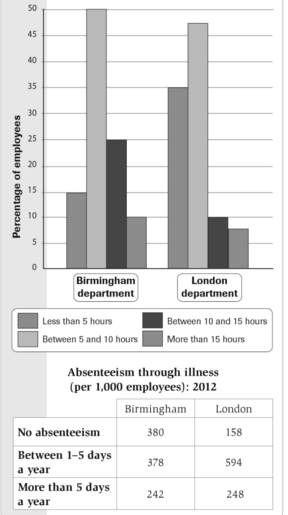The chart and table below give information about exercise and absenteeism in two departments of a major company (Based on 2012 survey)
A breakdown of the proportion of employees related to exercise and absenteeism in two departments of a large company in 2012 is illustrated in the bar chart and table. Overall, there are similarities and differences between the two departments engaged in the amount of hours spent exercising each week, while majority employees did it between five and ten hours. We can also see that those missing due to illness were varied in both places.
The figure for employees exercised between five and ten hours fairly similar in Birmingham and London department, accounting for below 50%. However, those in Brimingham doing workout for less than five hours a week was considerably lower than London,more employees in Brimingham exercised between ten and fifteen hours. These had a gap around 15%. Others saw less marked difference.
Based on the absenteeism due to ill health, Birmingham had over twice as much as no absence than London, with 380 and 158 employees.Interestingly,London department was recorded 216 employees missing lower than Brimingham one. Meanwhile, the absenteeism for more than 5 days a year in both of company bore fairly similar to each other, with around 242 employees.
A breakdown of the proportion of employees related to exercise and absenteeism in two departments of a large company in 2012 is illustrated in the bar chart and table. Overall, there are similarities and differences between the two departments engaged in the amount of hours spent exercising each week, while majority employees did it between five and ten hours. We can also see that those missing due to illness were varied in both places.
The figure for employees exercised between five and ten hours fairly similar in Birmingham and London department, accounting for below 50%. However, those in Brimingham doing workout for less than five hours a week was considerably lower than London,more employees in Brimingham exercised between ten and fifteen hours. These had a gap around 15%. Others saw less marked difference.
Based on the absenteeism due to ill health, Birmingham had over twice as much as no absence than London, with 380 and 158 employees.Interestingly,London department was recorded 216 employees missing lower than Brimingham one. Meanwhile, the absenteeism for more than 5 days a year in both of company bore fairly similar to each other, with around 242 employees.

absent.png
